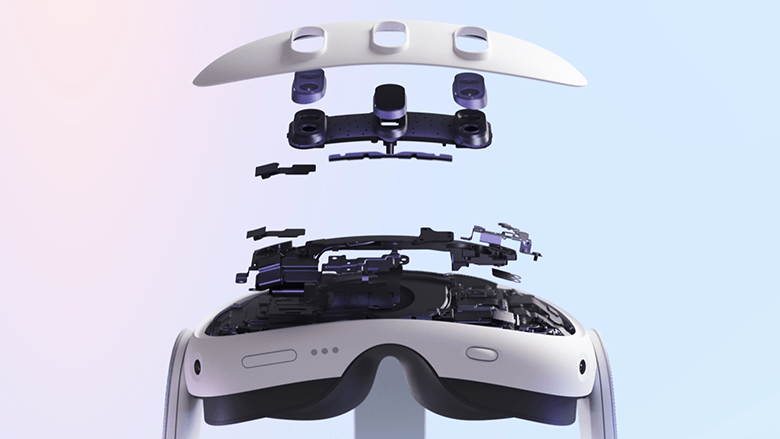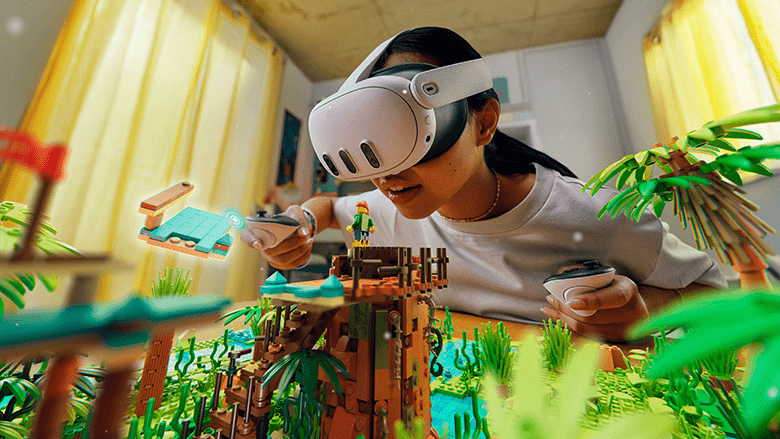Lighter, better and mixed realities: The self-sufficient Meta Quest 3 as portable all-in-one VR glasses is somewhat more expensive than the competition and some predecessor glasses. In our first test, you can find out why the latest offspring from the Meta Group is already starting to convince us. First test? We want to compare with other mobile headsets for a longer time. But first things first.
The fact that it is also a pleasure to unpack a new VR headset has been copied a little from Apple. But we've known this since the first PCVR glasses from the Facebook company. At first I thought the Quest 3 had lost weight compared to the Quest 2. In fact, the new VR headset weighs about 503 grams compared to 515 grams.
Suitable again for large eye distances
Although I use the separately available headband with the predecessor glasses, the Quest 3 can also score with the standard headstrap after a little getting used to. As with many headsets, the strap can be adjusted both above and behind the head. What I never noticed at first: you can even pull apart a kind of belt buckle at the back of the head to fix the VR glasses even better, which gives the mobile VR glasses a very comfortable hold. A physical IPD regulator that allows a clear image even for me with a wide eye relief is integrated again. The scale, which can now again be adjusted in millimetres, ranges from 58 to 70 mm. With the predecessor, the interpupillary distance was only designed for a maximum of 68 millimetres in three scales.

Improved Passthrough Mode
The two most striking innovations include two front RGB cameras and a depth sensor. As with the Pico 4, you can now see the outside world in colour through the two pancake lenses when you set up the virtual zone or are outside your defined room boundaries. In theory, it is almost possible to follow mobile phone messages through the virtual glasses, but this is not advisable in the long run because of the flicker effects. In any case, I'm already looking forward to the day when this will be possible with even higher-resolution sensors.

Soon furniture advertising from Facebook?
Similar to the PSVR 2, tables, sofas and TV furniture are already captured with geometry grids without having to draw the boundaries yourself first. I particularly like the fact that it is now possible to start a VR experience at any time while sitting or standing again, without having to redefine the room boundaries each time.
A bit creepy: Meta now asks for the first time whether spatial data of your home can be used when installing the mixed reality applications that are superimposed on the real environment. (I'm already curious whether we'll one day see volumetric, tailor-made furniture ads displayed when advertisers use this valuable data).
Content is still missing
According to Meta, about 100 games will be optimised for the Quest 3 by the end of 2023. There are currently many games in development. Practically the entire library (around 500 titles) of Meta Quest 2 etc. is backwards compatible. In addition, some titles specially optimised for the Quest 3 are currently being developed, as well as other MR apps.
Graphically, I haven't noticed a huge difference in games so far, as the Pico 4 already has a comparably high display resolution (per eye 2064 × 2,208 Px for Quest 3; 2160 × 2160 Px for Pico 4; 1832 × 1920 Px for Quest 2). More games like "Asgard's Wrath" and "Assassin's Creed Nexus" will be released soon. No Quest 3-exclusive titles have been announced at Meta Connect to date until the end of this year. Still, there are some games like "The Walking Dead: Saints and Sinners", "Hubris" and "Espire 2" that take advantage of the extra performance. Of course, this is nowhere near the level of PCVR with a mobile SoC platform, but it is surprisingly good. Furthermore, like almost every other mobile headset, the Quest 3 can be connected to a powerful PC via the Virtual Desktop app to stream via Steam VR.
This is fun
If the Quest 3 includes a feature that has really managed to derail a few "wows" for me, it is the use of Mixed Reality through the new depth sensor, although I have only tested a few of the few applications. In the game "Cubism", for example, you sit quite relaxed in the living room while you assemble various cubic puzzle pieces above the parlour table. It's really nothing more than a puzzle game, just in 3D. There is even a cool but entertaining MR game called "First Encounters" for free. After launching the app and scanning the room, a spaceship crashes through your parlour ceiling and will make for a colourful living room battlefield with an annoying blast of space slimeballs. The player's task is to collect as many of these "puff balls" as possible before time runs out.
The alternative gesture control via hand tracking also responds somewhat more precisely. As with the previous glasses, the gesture tracking allows clicks and zooms based on various thumb and index finger movements, which feels very natural. The compact small controllers were also convincing, although their basic functions and button layouts have not changed much, but now, with the elimination of the large tracking rings, they are reminiscent of the first generation of Oculus Touch controllers for the PC.

First impression
Since the Quest 3 arrived a little late on our editorial desk, it is still too early for a final verdict. It depends on what you expect as a consumer: For example, do you want a cheap pair of wireless VR glasses for your PC VR games, assuming you already have your powerful PC? Then the Pico 4 is clearly more worthwhile, because the resolution of the lenses and the wearing comfort are comparably good, if not even better. Do you really want Mixed Reality at a steep extra price? We are still waiting for more MR applications, but also for exciting titles like "Asssassin's Creed Nexus" and "Asgard's Wrath 2", which will be released soon. In terms of price, the 128 GB version is in the range of the comparatively still expensive PSVR2 at around 539 francs. The Pico 4, on the other hand, is still very cheap in comparison (this stand-alone headset is already available for 359 francs in the 128 GB version).









